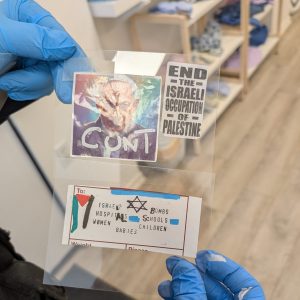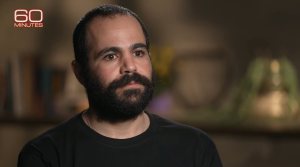 Have you ever thought of Sukkot as a holiday that celebrates the sustainable Jew?
Have you ever thought of Sukkot as a holiday that celebrates the sustainable Jew?
In ancient Israel, Sukkot had a major agricultural focus. The celebration was a thanksgiving for the fruit harvest and the blessings of nature in the year that had passed.
Some members of the Winegust family sit atop the Cottonwood Pass, west of Buena Vista, Colorado. From left, are Zev, Marc, Yardena, Adira and Tamara Winegust. [Fred Winegust photo]
Today, Sukkot is a Jewish festival for which we step out of the comfort of our own homes and enter temporary dwellings where we are exposed to the vagaries of the weather while performing the mitzvah of leshev basukkah.
As you sit in the sukkah, think about the roof. The schach must be made from some product of the Earth, which is no longer attached to the Earth. Wood of all kinds, including bamboo poles, leafy branches and branches of pine trees, are considered good for schach.
Another aspect of Sukkot is the bringing together of the etrog, lulav, hadassim and aravot. According to the midrash, each of these four represent different mixes of aroma and taste, and in a way represent the different mixes of Torah observance and good deeds of Jewish individuals. When we bring these four items together, they represent a communal whole.
Sukkot is also connected with water. The Talmud teaches that during the festival of Sukkot, HaShem judges the world over its water. On the final day of the holiday, special prayers are offered, imploring on High to provide rain and sufficient water.
All of this ties together harvest, lulav, etrog, hadassim, aravot and water; they are all part of a natural system that takes carbon dioxide out of our air and converts it to oxygen. The plants that we use to supply the sukkah’s schach and which make up the lulav/ etrog combination depend on water and are not destroyed in the process, but continue to grow and regenerate year after year.
From year to year, the weather we are in contact with over the Sukkot period changes, depending on the timing of the arrival of the holiday. This small slice of outdoor weather started me thinking about the climate we are living in, and what going into a sukkah would mean in the years to come.
Are we as a people, in the Diaspora or in Israel, taking actions that minimize our impact on the environment and leave this world a better place for our children?
Do we know what is happening to our environment and why? Do we know the actions we can take that can make a difference? Do we know and act? Do we know yet fail to act? Do we act without knowing the reason why? Do we do nothing?
Are we as Jewish individuals, families, communities or as a people doing what we can to influence others to live a more sustainable life through knowledge and actions?
I began to think more about this question after returning from a 10-day family adventure to the American Rockies. For years, I have regaled my family with stories of my late 1980s business trips to Vail and Boulder, Colo. I convinced them of the value of enjoying the fresh mountain air and seeing the snow-capped mountains and glaciers, even in the summer.
When we finally reached the mountains, which are more than 14,000 feet high, my family was struck by the lack of snow and the small size of the few remaining glaciers. I’m sure those of you who have been to the Canadian Rockies in Alberta have seen a similar glacial retreat at the Columbia Icefield.
My youngest son, Zev, wanted to know what happened and where all the snow went. The simple answer to an 11-year-old was, “It melted.” The comeback of an 11-year-old, raised on the Discovery Channel and Mythbusters, and his four siblings, who were raised on Bill Nye the Science Guy, was, “Why?”
“It melted” was not going to satisfy them. It took a visit to the National Center for Atmospheric Research (NCAR)in Boulder to put the answer into perspective. The scientists at NCAR are part of a team of 300 scientists, representing 160 research groups in 48 countries who contributed to a report titled State of the Climate in 2009.
This report documented measured decreases in snow cover, sea ice and glaciers, and increases in air temperature, humidity, ocean heat and temperature, sea level and temperature both land and sea. The report also led to the July 29 Globe and Mail headline “Signs of warming Earth are unmistakable” and an Aug. 30 Maclean’s magazine cover story called “Extreme weather warning.”
When the NCAR tour guide found out that I was recently trained by former U.S. vice-president and environmental activist Al Gore to be a volunteer presenter for the Climate Project, she asked me to explain the issues behind global warming to the 30 people on the tour. An NCAR exhibit on the second floor enabled me to explain the reasons behind the melting glacier
I explained how the sun emits radiation and how most of this radiation is absorbed by the Earth and warms it. Some of the energy is radiated back into space by the Earth in the form of infrared waves and some of this outgoing infrared radiation is trapped by the Earth’s atmosphere and warms it. Increased levels of greenhouse gases in the atmosphere end up trapping more infrared radiation, causing a further increase in temperatures.
The answer was more than enough to satisfy the curious, but not enough for my eldest daughter, Tamara. She said, “Cousin Jeff says that all of this is occurring due to natural and not man-made causes.”
“What are these greenhouse gases anyway?” added my 17-year-old son, Marc.
No need to answer all of these probing questions right away, as it was time to go see the dinosaur bones at Dinosaur Ridge, west of Denver. Perhaps there was a way for my family to discover that both natural and man-made elements can play a role in global warming and species extinction.
Seeing dinosaur tracks in 60-million-year-old exposed stone took their mind off the problems of melting snow and global warming.
When we reached the Field Museum in Chicago, we saw an evolution exhibit featuring dinosaurs. Part of the exhibit hypothesized that the changes we have seen on Earth over a period of time have been influenced by changes in climate. One of the key displays was about natural cycles of climate change, explained by the Milankovitch cycles. These cycles are made up of natural variations in the relationship between the Earth and the sun; the orbit of the Earth around the sun; the degree of the Earth’s tilt; the direction of the Earth’s axis of rotation. This phenomenon is part of existing climate science.The observed cyclical temperature increases are not caused by increases in greenhouse gases, but due to natural warming and cooling cycles.
The current theory is that the end of the dinosaurs was caused by climate change resulting from a meteor hitting the Earth. The impact sent so much particulate matter into the atmosphere that the sun was blocked, which preventing the sun’s radiation from heating the Earth and led to a dramatic cooling of the Earth. The Milankovitch cycles did not have anything to do with the extinction of the dinosaurs.
The Field Museum exhibit showed that man-made and naturally occurring gases can have a similar climate-changing impact, in the direction of heating the planet. This was my chance to tell my children what greenhouse gases are.
Different human-caused greenhouse-gas pollutants are increasing the amount of infrared radiation being trapped, leading to these temperature increases. There are six families of greenhouse-gas pollutants, which appear in various proportions and are being tracked, inventoried and targeted for reduction.
Electricity generation, industrial and agricultural activities, landfill, heating and cooling, deforestation and transportation are just some sources of greenhouse-gas emissions. These gases include carbon dioxide (CO2 ), methane, black carbon or soot, halocarbons, carbon monoxide, volatile organic compounds and nitrous oxide.
The measure of CO2 concentration in the atmosphere was below 300 parts per million (PPM) in the 800,000 years prior to the Industrial Revolution, when scientists believe that the Milankovitch cycles operated without the need to accommodate for any human-generated activity.
A CO2 concentration of 350 PPM has been declared the “danger” number. Recent scientific measurements put us at a CO2 concentration of 390 PPM, and the growth in the number is accelerating. With more greenhouse gases in the atmosphere, more infrared radiation is being trapped, leading to more heating. As the PPM number continues to rise, we are seeing the effects of melting ice and the other factors documented in the State of the Climate in 2009.
Various environmental accords setting targets to reduce greenhouse gases to 1990 levels, or to percentages of levels measured in an earlier year, by a certain target date are trying to slow the acceleration of atmospheric CO2 concentration and then, if possible, reverse it to less dangerous levels.
My hope is that by gaining a better understanding of the various sources of greenhouse-gas pollution, we can inspire ourselves to take the first steps in personal, community and business action, and become sustainable Jews.
Can we change energy consumption patterns, alter product supply chains, exploit business opportunities to commercialize scientific discoveries, or find new ways to apply technology to reducing greenhouse-gas emissions?
There is an immediate problem and an urgent need to act. There are steps you can take that will have a positive measurable impact. Using energy-saving light bulbs and implementing home and office retrofits of lighting, heating and air-conditioning systems can measurably decrease energy consumption and allow coal-generated electricity plants to be turned off. These are some of the steps you can take now.
As we enter the period of Sukkot and put ourselves closer to nature by sitting outside under a green canopy in our sukkah, we should start to think about the type of world we are living in today, what we will be leaving to our children and grandchildren tomorrow, and the sustainable actions we will need to take as Jews, as individuals, as a community, as a country and as members of humanity, to ensure that we leave the world in a better state.
Fred Winegust is an independent consultant who focuses on the business value of sustainable technology.






